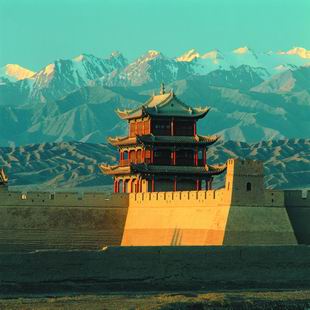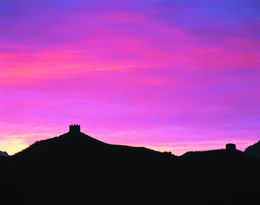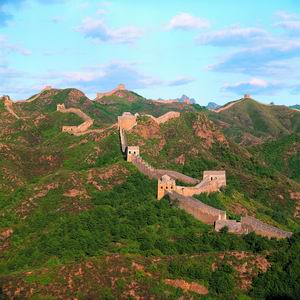 I am sitting on top of the Great Wall as I am writing this, an oxmoron as I am using a piece of high modern technology atop a piece of the worlds oldest technology. I am looking out over Mongolia to the north, and China proper to the south, high above the border between the two on the oldest highway in the world. I am walking (although not currently, as you may well guess) a four and a half kilometre section that stretches between Jinshanling and Simatai Village. This section is one of the better sections for tourists to come to, because it brings together some of the greatest attributes of the wall for westerners and other curious parties alike, and avoids the tacky, kitschy areas like Badaling and Mutianyu which are, granted, closer to Beijing proper, but are full of tourists and "attractions"as well as bad music. If you want the wall without any other attractions than the wall itself, I recommend walking this route, but don誸forget to bring your own pack lunch. One thing to note, before you start your trek, is that you will want to hurry in the beginning of your walk if you want to get to Simatai. The walk covers two stretches of wall, of which you will have to pay entrance to both. Insgroupsto get the best sightseeing and dollar value, you will want to see both. Going quickly in the beginning means that you will have time at the end to climb up to the peak of Simatai, and still make it back down in time to catch your bus home. I am sitting on top of the Great Wall as I am writing this, an oxmoron as I am using a piece of high modern technology atop a piece of the worlds oldest technology. I am looking out over Mongolia to the north, and China proper to the south, high above the border between the two on the oldest highway in the world. I am walking (although not currently, as you may well guess) a four and a half kilometre section that stretches between Jinshanling and Simatai Village. This section is one of the better sections for tourists to come to, because it brings together some of the greatest attributes of the wall for westerners and other curious parties alike, and avoids the tacky, kitschy areas like Badaling and Mutianyu which are, granted, closer to Beijing proper, but are full of tourists and "attractions"as well as bad music. If you want the wall without any other attractions than the wall itself, I recommend walking this route, but don誸forget to bring your own pack lunch. One thing to note, before you start your trek, is that you will want to hurry in the beginning of your walk if you want to get to Simatai. The walk covers two stretches of wall, of which you will have to pay entrance to both. Insgroupsto get the best sightseeing and dollar value, you will want to see both. Going quickly in the beginning means that you will have time at the end to climb up to the peak of Simatai, and still make it back down in time to catch your bus home.
 I came to the great wall in the early morning with a tour arranged by the Yuan Dong Fang Dian, a hostel in the Qianmen area. The tour left at eight thirty in the morning, and we arrived at Simatai by bus before ten o'lock. From there, thesgroupsof six that I was with all got off of our large bus, and boarded a small, loaf of bread style minivan to head over to Jinshanling. The inside of the bus was deceptively small, but we all fit without too much discomfort. The only thing we had to remember was not to sit up straight, lest we wanted our heads pressed against the ceiling for the duration of the ride, and a headache from whenever we hit a bump. The spot over the drivers head was worn away sufficiently to let us all know to keep our heads down while moving. I came to the great wall in the early morning with a tour arranged by the Yuan Dong Fang Dian, a hostel in the Qianmen area. The tour left at eight thirty in the morning, and we arrived at Simatai by bus before ten o'lock. From there, thesgroupsof six that I was with all got off of our large bus, and boarded a small, loaf of bread style minivan to head over to Jinshanling. The inside of the bus was deceptively small, but we all fit without too much discomfort. The only thing we had to remember was not to sit up straight, lest we wanted our heads pressed against the ceiling for the duration of the ride, and a headache from whenever we hit a bump. The spot over the drivers head was worn away sufficiently to let us all know to keep our heads down while moving.
When we arrived at the wall, we paid our fee at the front desk of around thirty Yuan US# 3.5. From that point on, we had company to guide us up the hill to the wall itself. We knew that they were going to try and sell us something at some point, but we did not mind the company as they did not immediately start pushing us to buy. Instead, a man and two women walked up the hill with us, showing us shortcuts around steps and through the bushes, and making jokes in Chinese that could be understood by an elementary speaker. They were nice, and brought us to the top before they started to hawk their wares. Then they pulled out books, and postcards, and other such trappings of great wall salesmen and women. We wanted none of it, and told them kindly so. They persisted, but we simply told them that we had no money, and therefore could not buy anything, no matter how pretty or historical the pictures were. They finally got the picture and stepped away and we began our hike down the wall to Simatai.
 As we walked, I looked out over the scenery stretched out before me on either side of the wall. The wall snakes through Jinshanling, going up fromswhereswe started through tiers of hills that lead up to the crescendo of Simatai. We had come in the off season, and as such the lush green hills we had seen in the vendors books were not yet in bloom, and we were left with a scenery that I felt was perhaps, even more fitting of a surround for the Great Wall: dry desolate hills, mottled brown and grew, covered with the grey stalks and twigs of bushes that had dried in the cold winter of the north China plain, waiting for the rains and the sun to rejuvenate them. It gave the wall an even more antiquated and Spartan feel, as one felt instantly transported backwards in time to when the Mongol hordes would have come thundering on their horses towards the wall, coming to loot the Middle Kingdom. As we walked, I looked out over the scenery stretched out before me on either side of the wall. The wall snakes through Jinshanling, going up fromswhereswe started through tiers of hills that lead up to the crescendo of Simatai. We had come in the off season, and as such the lush green hills we had seen in the vendors books were not yet in bloom, and we were left with a scenery that I felt was perhaps, even more fitting of a surround for the Great Wall: dry desolate hills, mottled brown and grew, covered with the grey stalks and twigs of bushes that had dried in the cold winter of the north China plain, waiting for the rains and the sun to rejuvenate them. It gave the wall an even more antiquated and Spartan feel, as one felt instantly transported backwards in time to when the Mongol hordes would have come thundering on their horses towards the wall, coming to loot the Middle Kingdom.
The rest of the wall at this site lent the same feel to the air, as the wall was not fully restored, or even partially restored in most of the parts along the way until you arrive at Simatai. Being such, the disrepair makes one again feel like they are walking through time, as the wall shows its age and use, and in that, its dignity. The brown/grey tone of the mountains and surrounding landscape, matches the colour of the brickwork in the wall. The two, it seems, are hewn from the same earth, and both look dry enough to crumble in your hand.
When you start walking away from Jinshanling, headed towards Simatai, the increase in height constantly opens out more for the eye to see, both of the land, and of the wall itself as it makes its waysintosthe distance. Behind, you can see the wall snaking along atop the mountains, fading offsintosthe distance, diminishing in size and scalesintosthe mountains which support it. The thin line far in the distance can barely be seen above the mist at the mountains bases. In front of you, you can see the wall moving away and fromswheresyou stand. It is daunting, as you see in the distance the heights you have yet to scale.
Underfoot, the wall again is quite spectacular, in its conception, creation, and conservation. The wall it seems was paved over several times, a fact evidenced in the rubble. In some patches, the tamped dirt underneath the flagstones and brickwork was visible, and you could scuff at it with your feet. The wall itself is built on this dirt, which lends incredible structural integrity to it. The dirt is as hard as concrete, and some say that inside its mounds lay the bones of those who worked on it ceaselessly over the centuries. In some sections, on top of that rammed earth, you could see there was a layer of cobblestones originally making up the surface of the wall. However, over the years, and perhaps during the Ming restoration of the wall, these smaller stones were covered again by flagstones. It is amazing to think of the masonry that had to gosintosthe construction of the wall, because rather than using molded brick, many of the stones were hand carved. Along this route however, there is also a section that is covered in bricks that are stamped with ancient characters.
Thinking of these stones, and the immense quantity of them, one becomes incredibly aware of the logistics of the construction of such a wall. The height of the mountains that it is on make it not only a process to build, but an incredible process of importing and creating materials for the construction, and to supply the workmen whose labour built the wall with food, drink, and shelter from the elements.
When you are almost done with the walk to Simatai, you will know, as a man will approach you and ask for another entrance fare. You must pay him if you want to catch your bus, and if you want to get the to peak of Simatai which you can now finally see off in the distance. Simatai stretches high aboveswheresyou stand, and is quite a vertical hike, so not for the faint of heart at the end of a long walk. However, the restored Ming era wall, the height of the wall, and the incredible vistas make it worthwhile both in practice and in memory, especially with the waning light at the end of a day, the countryside and the wall are especially beautiful.
From there, it is a steep climb home, and one for the sure footed. Take care on the way down not to slip, since the bus will wait if you are only a few moments late, and it is not worth your health to get back any faster. Take your time, and when you finally do reach the bottom, you will be hungry and tired, but most of all, happy you came.
|
![]() 本网站由北京信息港提供网络支持
本网站由北京信息港提供网络支持
![]() 本网站由北京信息港提供网络支持
本网站由北京信息港提供网络支持